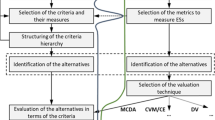Abstract
It is widely accepted that wetland ecosystems are under threat worldwide. Many communities are now trying to establish wetland rehabilitation programs, but are confounded by a lack of objective information on wetland condition or significance. In this study, a multi-criteria decision-making method, TOPSIS (the Technique for Order Preference by Similarity to Ideal Solution), was adapted to assist in the role of assessing wetland condition and rehabilitation priority in the Clarence River Catchment (New South Wales, Australia). Using 13 GIS data layers that described wetland character, wetland protection, and wetland threats, the wetlands were ranked in terms of condition. Through manipulation of the original model, the wetlands were prioritized for rehabilitation. The method offered a screening tool for the managers in choosing potential candidate wetlands for rehabilitation in a region.



Similar content being viewed by others
Literature Cited
Abbruzzese B., S. G. Leibowitz. 1997. A synoptic approach for assessing cumulative. impacts to wetlands. Environmental Management 21:457–475
Bartoldus, C. 1999. A comprehensive review of wetland assessment procedures: A guide for wetland practitioners. Environmental Concern Inc., St. Michaels, Maryland. 196 pp
Bartoldus C. 2000. The process of selecting a wetland assessment procedure: Steps and considerations. Wetlands Journal 14:4–40
Braglia M., M. Frosolini, R. Montanari. 2003. Fuzzy TOPSIS approach for failure mode, effects and criticality analysis. Quality and Reliability Engineering International 19:425–443
Brooks R. P., D. H. Wardrop, J. A. Bishop. 2004. Assessing wetland condition on a watershed basis in the Mid-Atlantic Region using synoptic land-cover maps. Environmental Monitoring and Assessment 94:9–22
Budge, D. T. 1998. Clarence catchment wetlands survey. Department of Land and Water Conservation report. NSW, Australia, 60 pp
Çaldag B., L. Saylan. 2005. Sensitivity analysis of the CERES – wheat model for variations in CO 2 and meteorological factors in Northwest Turkey. International Journal of Environment and Pollution 23:300–313
Carletti A., G. A. De Leo, I. Ferrari. 2004. A critical review of representative wetland rapid assessment methods in North America. Aquatic Conservation: Marine and Freshwater Ecosystems 14:S103–S113
Fennessy, M. S., A. D. Jacobs, and M. E. Kentula. 2004. Review of Rapid methods for Assessing Wetland Condition. EPA/620/R-04/009. U.S. Environmental Protection Agency, Washington, D.C., 75 pp
Findlay S. E. G., E. Kiviat, W. C. Nieder, E. A. Blair. 2002. Functional assessment of a reference wetland set as a tool for science, management and restoration. Aquatic Science 64:107–117
Finlayson M. 2003. The challenge of integrating wetland inventory, assessment and monitoring. Aquatic Conservation: Marine and Freshwater Ecosystems 13:281–286
Gibbons J.D. 1976. Nonparametric methods for quantitative analysis. Holt, Rinehart and Winston, New York, 463 pp
Harris M. 1999. Upland Wetlands of the Clarence Catchment, North Coast New South Wales: Condition and Threats. Department of Land and Water Conservation report. NSW, Australia, 23 pp
Herath G. 2004. Incorporating community objectives in improved wetland management: the use of the analytic hierarchy process. Journal of Environmental Management 70:263–273
Hruby T. 1999. Assessments of wetland functions: what they are and what they are not. Environmental Management 23:75–85
Hwang C. L., K. Yoon. 1981. Multiple Attribute Decision Making: Methods and Applications. Springer-Verlag, New York
Kingsford R. K. 2000. Ecological impacts of dams, water diversions and river management on floodplain wetlands in Australia. Austral Ecology 25:109–127
Kubo T., T. Kohyama. 2005. Abies population dynamics simulated using a functional– structural tree model. Ecological Research 20:255–269
Levin S. A. 1992. The problem of pattern and scale in ecology. Ecology 73:1943–1967
Locantore N. W., L. T. Tran, R. V. O’Neill, P. W. Mckinnis, E. R. Smith, M. O’Connell. 2004. An overview of data integration methods for regional assessment. Environmental Monitoring and Assessment 94: 249–261
Milani A.S., A. Shanian, R. Madoliat, J.A. Nemes. 2005. The effect of normalization norms in multiple attribute decision making models: a case study in gear material selection. Structural and Multidisciplinary Optimization 29:312–318
Mitsch W. J., R. H. Mitsch, R. E. Turner. 1994. Wetlands of the Old and New worlds: ecology and management. In W. J. Mitsch (eds.), Global wetlands: Old World and New. Elsevier Press, New York. Pages 3–56
Olson D. L. 2004. Comparison of weights in TOPSIS models. Mathematical and Computer Modelling 40:721–727
Rolander, N., A. Ceci, and M. Berdugo. 2003. A framework to MCDM method selection. Georgia Institute of Technology report, 171 pp
Saloranta T. M., J. Kamari, S. Rekolainen, O. Malve. 2003. Benchmark criteria: A tool for selecting appropriate models in the field of water management. Environmental Management 32:322–333
Schweiger E. W., S. G. Leibowitz, J. B. Hyman, W. E. Foster, M. C. Downing. 2002. Synoptic assessment of wetland function: a planning tool for protection of wetland species biodiversity. Biodiversity and Conservation 11:379–406
Siegel S., J. Castellan. 1988. Nonparametric statistics for the behavioural sciences. 2nd edn. McGraw-Hill, New York
Sprent P. 1998. Data driven statistical methods. Chapman & Hall, London, 146 pp
Tong, L.-I., C.-H. Wang, and H.-C. Chen. 2005. Optimization of multiple responses using principal component analysis and technique for order preference by similarity to ideal solution. The International Journal of Advanced Manufacturing Technology. 27:407–414
Triantaphyllou E., C.-L. Lin. 1996. Development and evaluation of five fuzzy multiattribute decision-making methods. International Journal of Approximate Reasoning 14: 281–310
Triantaphyllou E., B. Shu, S. Nieto Sanchez, T. Ray. 1998. Multi-criteria decision making: an operations research approach. In J.G. Webster (eds.), Encyclopedia of electrical and electronics engineering, Vol. 15. John Wiley & Sons, New York. Pages 175–186
Tzionas P., I. Ioannidou, S. Paraskevopoulos. 2005. A hierarchical fuzzy decision support system for the environmental rehabilitation of Lake Koronia, Greece. Environmental Management 34:245–260.
Zar J. H. 1999. Biostatistical analysis. 4th ed. Prentice Hall, New Jersey
Acknowledgments
This project was funded by the National Heritage Trust of Australia through the Northern Rivers Catchment Management Authority. C. Liu is funded by the University of New England Vice-Chancellor’s postdoctoral fellowship.
Author information
Authors and Affiliations
Corresponding author
Rights and permissions
About this article
Cite this article
Liu, C., Frazier, P., Kumar, L. et al. Catchment-Wide Wetland Assessment and Prioritization Using the Multi-Criteria Decision-Making Method TOPSIS. Environmental Management 38, 316–326 (2006). https://doi.org/10.1007/s00267-005-0151-0
Published:
Issue Date:
DOI: https://doi.org/10.1007/s00267-005-0151-0




